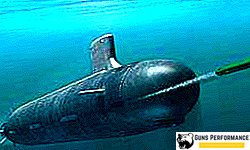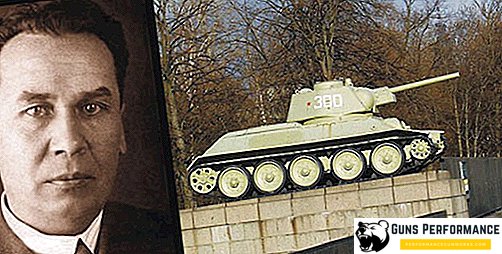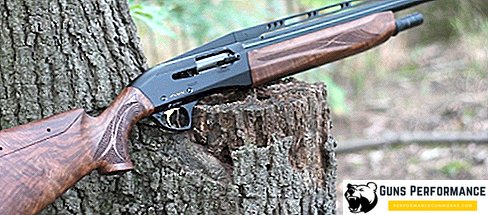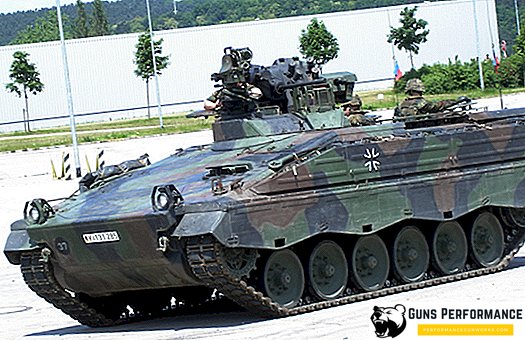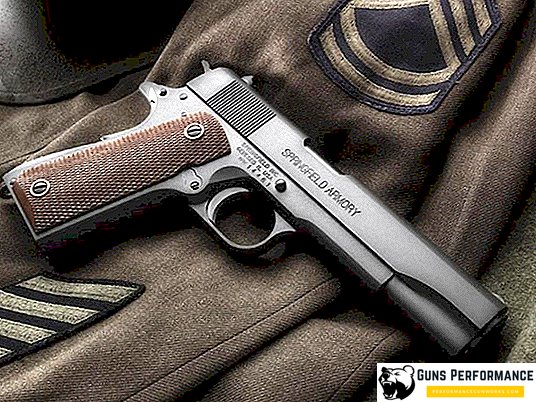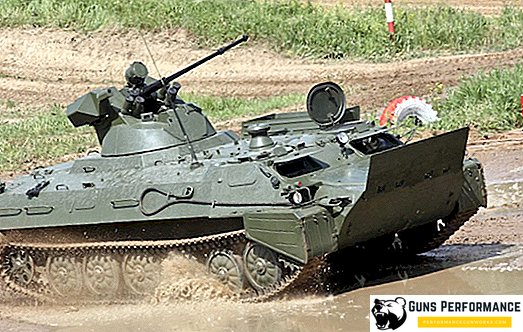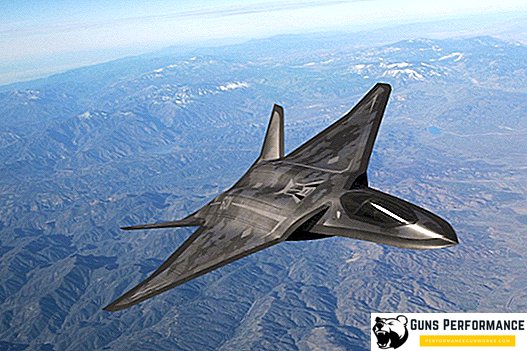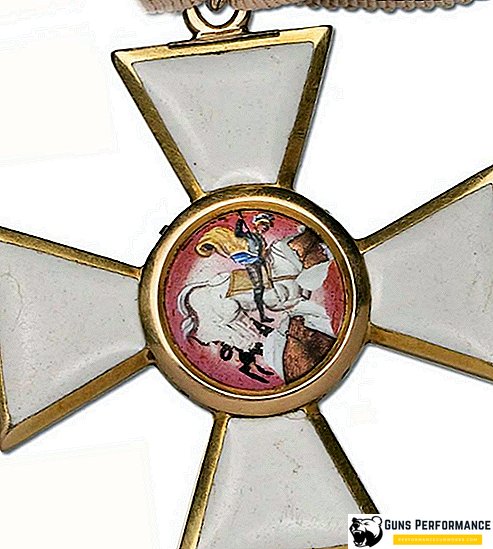
SAU 2S7 "Peony" - a Soviet 203-mm artillery, adopted for service in 1975 and upgraded in the mid-80s. Today the self-propelled gun "Pion" is one of the most powerful self-propelled guns in the world, and it is still used by the Russian army and armed forces of the former Soviet republics.
This artillery installation is designed to destroy enemy targets in its tactical rear. The main objectives for this "self-propelled gun" are the delivery of tactical nuclear weapons, long-term defensive fortifications, communications centers and enemy headquarters. The firing range of the SAU 2S7 "Peony" is 47 km. It is capable of firing ammunition with a nuclear warhead.
During the existence of the Warsaw Pact, the 203-mm self-propelled gun "Pion" was in service with the USSR, Poland and Czechoslovakia. Currently 2S7 used by the armies of Russia, Ukraine, Azerbaijan, Uzbekistan, Angola, Georgia and Belarus. In 2010, the Russian army was armed with 130 such installations.

History of creation
After the end of World War II, the world entered the nuclear age. The Cold War began, and its main participants began building up thermonuclear arsenals and developing new, more and more sophisticated means of delivering these weapons.
In the early 1960s, it became obvious that a total nuclear war was senseless and unlikely, since it would lead to the complete destruction of the parties involved in it. In the military environment, the theory of local war, using tactical nuclear weapons, became increasingly popular. The main goal in such a conflict should have been the enemy troops and the objects of its military infrastructure, and not peaceful cities.

In this context, the military leadership of the United States and the USSR was faced with the question of creating means of delivery for tactical nuclear weapons. The main of them were considered bombers, tactical missiles and artillery systems.
The Soviet Secretary General Khrushchev was very dismissive of the barrel artillery, in his opinion, the main striking force of the upcoming wars would be missiles. Almost all the programs for the development of new types of classical artillery were closed with him. Only after its displacement was the barrel artillery “rehabilitated”. At the end of the 60s, the USSR began implementing several projects related to the development of artillery systems of various purposes and calibers.
In 1967, an order was issued by the USSR Ministry of Defense Industry to begin work on self-propelled high-powered artillery. The firing range of the new ACS should have exceeded 25 km, and the caliber of the gun was to be chosen by the designers.
It was proposed several options for the new artillery, with different caliber guns (180 and 210 mm) and chassis. In 1969, it was decided to stop at the gun with a caliber of 203 mm. In the same year, the Kirov Plant presented a pilot project of the ACS "Peony" with a 203-mm instrument and open cutting. For the new machine it was proposed to use the chassis of the T-64 tank. The designers of the Volgograd plant "Barricades" presented a draft of their self-propelled guns based on the object 429.
As a result, it was decided to combine these two projects: the Kirov Plant became the lead developer of the ACS 2S7 “Pion”, and the creation of a gun was started in Volgograd. In 1973, the tactical and technical characteristics (TTH) of the new artillery installation were finally approved. Beskoskotnaya range 2S7 "Peony" was to be from 8.5 to 35 km for high-explosive fragmentation projectile. Also, the military demanded that the new SAU could fire 3VB2 ammunition with a nuclear warhead.

The combat part of the machine, the development of which was engaged in the "Barricades", in general, had a classical scheme, but there were some special features in it. In particular, the gun barrel was made collapsible. The reason for this decision is very simple: large-caliber gun trunks wear out pretty quickly, it is much easier to install a new barrel on a self-propelled gun than to transport the car to the factory. Replacement is quite possible to make in the conditions of the front-line workshop.
In 1974, two samples of the new ACS were manufactured and sent for testing. In 1975, 2S7 "Peony" was adopted. Two years later, nuclear weapons were made in a caliber of 203 mm.
Serial production of 2S7 "Pion" was carried out at the Kirov factory in Leningrad, an instrument for it was made by the factory "Barricades". The last serial car was handed over to the troops in 1990. The total number of machines manufactured in sixteen years is 500 units. The cost of one self-propelled gun "Pion" for 1990 is more than 521 thousand rubles.
In the mid-80s, there was a need for the modernization of the Pion - the military was not satisfied with the power plant of the machine, there were questions about the undercarriage of the ACS. The upgraded version of the self-propelled gun was called 2S7M "Malka".
The car was equipped with a new, more advanced engine V-84B, which could use not only diesel fuel, but also gasoline and kerosene. Changes were made to the chassis of the ACS. The modernization allowed increasing the service life of the machine up to 8-10 thousand km.
In addition, the places of the commander of the vehicle and the gunner were equipped with new indicators, which reduced the time of transition to the combat position. Up to eight shots increased ammunition carried with them, and the crew, on the contrary, was reduced to six people. SAU 2S7M "Malka" began to be produced in 1986.
Description of the artillery installation

The ACS 2S7 "Peony" is made on a turretless design, the 203-mm gun is installed openly in the back of the machine. Self-propelled installation consists of a mechanized gun and body. The crew consists of seven people (the "Malka" - six).
The car body is divided into four compartments, during the march the crew is inside it. In front of the vehicle there is a department of management, it contains places for the driver, the commander of the vehicles and one more crew member. Next is the engine compartment with the engine, behind which the calculation office is located, with seats for three crew members and a gunner. Ammunition is also stored there. In the aft self-propelled gun installed 203-mm cannon and opener.
The Pion case has a two-layer reservation: the outer armor plates are 13 mm thick and the inner armor is 8 mm. The hull protects the crew not only from small arms bullets and fragments, but also from the effects of penetrating radiation. It weakens its action three times.
The main armament of the Pion is a 203-mm cannon, the maximum firing range of which is 47.5 km. The rate of fire of SAU is 1.5 shots per minute (2.5 - on the "Malka"). The tool consists of a barrel, bolt, loading chute, lifting and turning mechanisms, a cradle, an anti-recoil device, a loading mechanism, two balancing devices, a machine tool and sighting devices.

The shutter is equipped with a mechanical drive, through which it opens and closes (this can be done in manual mode), as well as a special balancing device that facilitates these operations.
Barrel and recoil devices are installed in the cradle of the swinging part of the gun. In turn, it is fixed on the machine. Anti-recoil devices consist of a recoil brake and two pneumatic knuckles installed symmetrically to the axis of the implement.
Swivel and lifting mechanisms provide guidance of the gun in the range from 0 to + 60 ° (vertical) and from −15 to + 15 ° (horizontal). Targeting is done with the help of hydraulic drives.
The projectile for the Pion weighs over one hundred kilograms, therefore, to facilitate the loading of the weapon, the ACS is equipped with a special mechanism that brings the projectiles to the loading line and sends them. This process is performed at any degree of elevation of the trunk. The mechanism is controlled from the charging console. First, a projectile is sent, after it a propelling charge, and then a primer tube is inserted into the socket of the firing mechanism.
Charging can be done from the ground or from the truck body. When loading shells from the ground using a special two-wheeled cart.
The self-propelled gun "Peony" can shoot both direct fire and closed positions. The 2S7 Peony ammunition consists of four ammunition, the Malka 2S7M, eight ammunition. The main self-propelled ammunition is usually in the transport vehicle that accompanies it. He is forty shells.
The self-propelled unit ammunition includes high-explosive fragmentation projectiles (firing range - 25.4 km), cluster munitions (firing range can reach 30 km) and active-jet projectiles (47.5 km). 203-mm self-propelled guns "Peony" can use shells with a nuclear warhead.
The Peony is additionally armed with a 12.7-mm machine gun and Strela-2 MANPADS. Also, the RPG-7 grenade launcher may be included in the calculation weapons kit.
For firing from closed positions, the gunner’s place is equipped with an PG-1M artillery panorama, and for direct fire, the OP4M-99A sight. To monitor the situation, the calculation is equipped with several periscopic TNPO-160 devices; they can be replaced with night vision devices.
On the ACS "Peony" installed diesel engine B-46-1 with twelve cylinders. Its capacity is 780 liters. with. On self-propelled 2S7M "Mavka" installed a more powerful multi-fuel engine V-84B (840 hp. Ps.). The transmission of the car is mechanical, there are seven front and one reverse gear.
The chassis of the car is based on the T-80 tank and consists of a pair of driving wheels, two guide wheels (rear), seven support rollers and six supporting rollers. The rear guide wheels can fall to the ground, thus increasing the stability of self-propelled installation when firing. Lowering the wheels is provided by hydraulic cylinders mounted along the axles of the wheels. Machine suspension - individual torsion bar.
To reduce recoil, a dozer opener is installed at the rear of the machine, which is lowered by means of a hydraulic drive. It can be buried in the ground to a depth of 700 mm. "Peony" is equipped with an additional diesel generator, which provides the hydraulic system during stops, when the engine SAU off.

Machines based on "Pion"
In 1994, the SKG-80 mobile heavy-duty crane was developed on the basis of the SAU 2S7, and its upgraded version SKG-80M appeared a bit later. Cranes weighed 65 tons and could lift a weight of 80 tons. By order of the Russian Ministry of Railways in 2004, an SM-100 crane was developed on the basis of the Pion ACS, capable of lifting locomotives and wagons that derailed.
In 1997 a trenching machine “Tundra” was developed for Russian engineering troops on the basis of "Pion" for digging trenches and trenches in frozen ground.

Combat use
The Soviet army has never used "Peonies" in battle. After the signing of the Treaty on Conventional Arms in Europe, all "Malki" and "Peonies" were transferred from the European part of the country.
SAU 2S7 was used by Georgia during the 2008 Russian-Georgian war. During the retreat, six self-propelled guns were lost. There is information about the use of "Pionov" Ukrainian army in the conflict in the east of the country.
Competitors "Pion"
At the time of the start of mass production of the Pion, the American army had self-propelled installations of 203 mm caliber (case gun M110). However, it was inferior to the Peony in almost all characteristics: in terms of firing range, ammunition load, power density. In the late 70s, two more new self-propelled guns, the M110A1 and M110A2, entered service with the US Army; their range reached 30 km. True, these cars were better armored compared to Peony.
In 1978, the 170-mm Koksan self-propelled gun was created in the DPRK; it could shoot 60 km, but it had a number of significant drawbacks: low mobility, low rate of fire and the lack of portable ammunition.
In the 1980s, several prototypes of a 210-mm self-propelled unit were manufactured in Iraq. However, the 1991 war and economic sanctions prevented the launch of this car in the series.
In the mid-90s, work on creating a high-powered self-propelled unit (203 mm) was carried out in China. It came to making prototypes, but the fate of this project is unknown.
Specifications
| Mass, t | 46 |
| Crew, pers. | 7 |
| Sizes, m | |
| Length | 13,2 |
| Width | 3,38 |
| Height | 3 |
| Armament | 203-mm howitzer 2A44 |
| Engine | diesel V-46-1 |
| Engine power, l. with. | 750 |
| Travel speed on the highway, km / h | 50 |
| Power reserve, km | 650 |
| Max. firing range, km | 47,5 |

Specifications (1976 sample)
- Years of production: 1976-1990.
- Total manufactured: at least 500 pcs.
- Combat use: military conflicts of the late XX - early XXI century.
- Crew - 7 people.
- Combat weight - 46 tons.
- Length - 13.2 m, width 3.9 m, height - 3 m, clearance - 400 mm.
- Armament: 203-mm howitzer, loading-separate sleeve, ammunition - 4 + 40 shots. 12.7-mm machine gun, ammunition - 300 rounds.
- Rate of fire: 1.5 shots / min.
- The maximum range of high-explosive fragmentation projectile - 37.5 km, active-projectile - 47.5 km.
- The main types of ammunition: fragmentation, high-explosive fragmentation, active rocket projectiles.
- Armor thickness: bulletproof.
- Diesel engine, power - 740/840 hp
- Maximum speed on the highway - 50 km / h.
- Cruising on the highway - 500 km / h.



